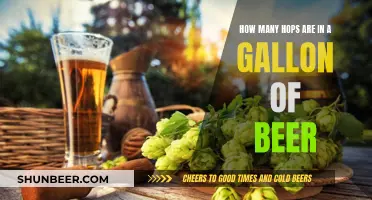
Stouts are a type of beer with a distinct appearance, flavour, and history. They are typically dark brown or black in colour, with a smooth, chocolatey taste and a thick consistency. While stouts are made with the same four basic ingredients as other beers—malted barley, water, hops, and yeast—it is the brewing process that sets them apart. In particular, the roasting of barley gives stouts their characteristic dark colour and rich flavour. Most stouts have minimal hop aroma, with many using bittering hops in the form of pellets or liquid extracts. However, some stout recipes do call for high-alpha hops, such as Magnum or Simcoe, for bittering.
| Characteristics | Values |
|---|---|
| Ingredients | Malted barley, water, hops, and yeast |
| Colour | Deep brown or black |
| Flavour | Coffee, chocolate, licorice, hazelnut |
| Texture | Creamy, silky, and full-bodied |
| Alcohol Content | 5.5% to 8% ABV |
| Hop Aroma | Minimal |
| Hop Usage | Balance out the malt |
What You'll Learn

Stouts have very few hops compared to IPAs
Stouts and IPAs are two types of beer with distinct differences. Both beers are made from the same four basic ingredients: water, malt, hops, and yeast. However, stouts have very few hops compared to IPAs.
Stouts were first recorded in the late 1600s as strong or heavy beers with high alcohol content. The term "stout porter" became popular as the beer was favoured by porters in London. Stouts are known for their dark colour, smooth, chocolaty taste, and thick consistency. The defining characteristic of a stout is its dark coffee colour, which comes from roasted barley. Chocolate malts are also added to enhance the colour and flavour. Stouts have very few hops compared to IPAs, and most have minimal hop aroma. Many stouts only use bittering hops in the form of pellets or liquid extracts.
IPAs, or India Pale Ales, were created in the late 1700s as an export beer to the British in India. Pale ales would not survive the journey, but the heavily hopped IPAs did. IPAs have a lighter caramel or amber colour, with fruity, citrusy, and floral tasting notes. They have a more bitter and watery texture than stouts. IPAs are almost overloaded with hops, which give them their bitter, edgy flavour.
While stouts and IPAs have some similarities, such as their English origin, they have very different flavour profiles and signature ingredients. Stouts rely on rich, roasted barley malt to create their flavour, while IPAs are characterised by their heavy use of hops.
Scottish Beers: More Hops or Just a Myth?
You may want to see also

Stouts are dry-hopped to keep the hop aroma low
Stouts, like all beers, are made from the basic four ingredients: water, malt, hops, and yeast. However, stouts are known for their distinct dark colour and rich flavour, which is achieved through the roasting of barley and the use of chocolate malts. While stouts are characterised by their deep brown or black colour, smooth, chocolatey taste, and thick consistency, they typically have a minimal hop aroma.
Stouts have a long history, dating back to the late 1600s when the term "stout" was first used to describe a strong or heavy beer with high alcohol content. Over time, the term became associated with porters, which were dark ales with hints of chocolate, coffee, or syrup. Eventually, the two styles merged to create "porter stouts" or darker and heavier versions of chocolaty, coffee-like beers. As the variety of stouts grew, the term "porter" was dropped, and stouts emerged as a category of their own.
Stouts are known for their rich, roasted flavour, which is primarily derived from the use of roasted barley. In addition to the barley, chocolate malts also contribute to the unique appearance and flavour of stouts. While hops are an essential ingredient in stouts, they are typically used sparingly, with most stouts having very few hops in comparison to other beer styles like IPAs. The hops that are used in stouts are primarily bittering hops, which can come in the form of pellets or liquid extracts.
While stouts typically have a low hop aroma, there are some variations within the style where hops play a more prominent role. For example, American Stouts and Russian Imperial Stouts can have a more aggressive hop aroma. Additionally, some brewers experiment with dry-hopping stouts, which can add unwanted fruity flavours but can also enhance the complexity of the beer.
Overall, while stouts do contain hops, they are used in smaller quantities and are not meant to be the star of the show. The primary role of hops in stouts is to balance out the rich, roasted flavours of the malt and barley, creating a harmonious blend that results in the unique flavour profile of stouts.
Sour Beers: Do They Have Hops?
You may want to see also

Hops are used to balance out the malt in stouts
Stouts have been around since the mid-17th century and were first recorded as describing a strong or heavy beer. They are easily recognised by their deep brown or black colouring, smooth, chocolatey taste, and thick consistency.
Like other beers, stouts are made from the classic four ingredients: malted barley, water, hops, and yeast. However, it's the way these ingredients are brewed that makes stouts different from other beers. The barley is what gives stouts their dark coffee colour. Roasted barley, in combination with chocolate malts, gives the beer its appearance and rich flavour.
Most stouts have minimal hop aroma. In fact, many stouts only use bittering hops in the form of pellets or liquid extracts. The hops are used to balance out the malt a bit. For example, Fuggles/East Kent Goldings hops are used in some stouts to balance out the malt characteristics.
Hops are the spice of beer. They provide bitterness to balance the sweetness of the malt, as well as flavours and aromas ranging from citrus and pine to earthy and spicy. Hops are added to the boil stage of brewing to unleash the "alpha" acids that bitter and balance the sweetness of the malt.
The Hoppy Truth: Do All Beers Have Hops?
You may want to see also

Stouts have a bittering hop in the form of pellets or liquid extracts
Stouts, like all beers, are made from the same four basic ingredients: water, malt, hops, and yeast. However, it is the way these ingredients are brewed that makes stouts unique. The defining characteristic of a stout is its dark coffee colour, which comes from roasted barley. In combination with chocolate malts, the roasted barley gives stout its appearance and rich flavour.
Stouts have very few hops compared to beers like IPAs. Most stouts have minimal hop aroma, and many only use bittering hops in the form of pellets or liquid extracts. The hops are used to balance out the malt a bit. For example, Fuggles/East Kent Goldings are often used in stouts.
For Imperial Stouts, a high-alpha hop like Magnum is often used for the bittering hop. When making an American stout, high-alpha American hops are also considered appropriate. However, when the ABV is lower (around 4-5%) and the IBUs are lower (around 35-50), hops like East Kent Goldings are preferred.
Beer Hops Allergy: What You Need to Know
You may want to see also

High-alpha hops are not traditionally used in stouts
Stouts, which first appeared in London pubs in the late 1600s, are known for their strong flavour, deep brown or black colour, and thick consistency. They are made from the classic four beer ingredients: malted barley, water, hops, and yeast. However, stouts have a very distinct brewing process that differentiates them from other beers.
The defining characteristic of a stout is its dark coffee colour, which comes from roasted barley. In addition to the colour, the roasted barley, in combination with chocolate malts, gives the beer its rich, smooth, chocolatey taste. Stouts are also known for having very few hops compared to other beers like IPAs. Most stouts have minimal hop aroma, and many only use bittering hops in the form of pellets or liquid extracts.
When it comes to the type of hops used in stouts, high-alpha hops are not traditionally used. High-alpha hops, also known as "super alphas", offer maximum bittering potential per ounce. They have an alpha acid content of 10% or higher, with some varieties reaching into the high teens. While these hops can provide a large amount of bitterness, they are typically used in bigger beers with lots of flavour. For more delicate beers, like stouts, lower alpha acid hops are usually used.
That being said, it is not unheard of to use high-alpha hops in stouts. Some brewers choose to use high-alpha hops for bittering in Imperial Stouts or American Stouts. Additionally, if a stout has a high ABV and a high IBU, a high-alpha hop may be used to keep costs down, as these hops provide a large amount of bitterness with a smaller amount of hops. However, using a different type of hop can change the flavour profile of the beer, so brewers need to be careful when substituting hops.
Hemp and Hops: Exploring the Botanical Cousins
You may want to see also
Frequently asked questions
Yes, stouts contain hops, but in small quantities compared to other beers like IPAs.
Hops are used to balance out the malt a bit. Most stouts rely on their rich, roasted barley malt to create their flavours and have very few hops in comparison to IPA beers.
The hops used in stouts are in the 5% Alpha Acids Units (AAU) range, and two ounces of hops are usually enough for a stout recipe. Some common varieties of hops used in stouts include Fuggles/East Kent Goldings, Nugget, and Centennial.
The distinct flavour and colour of stouts come from roasted barley or other chocolate-coloured malts. Stouts are known for their coffee, chocolate, licorice, and even hints of hazelnut flavours.







